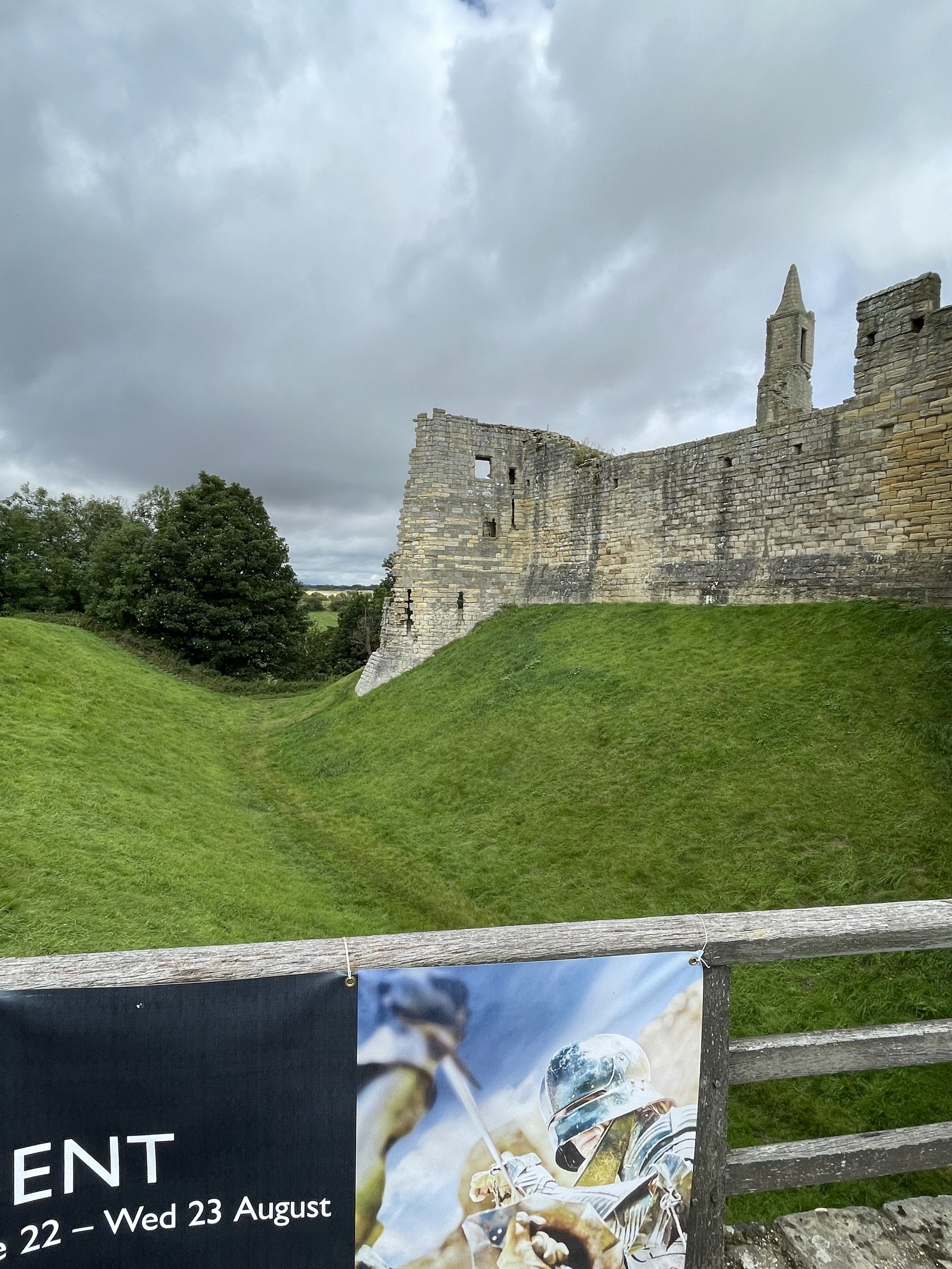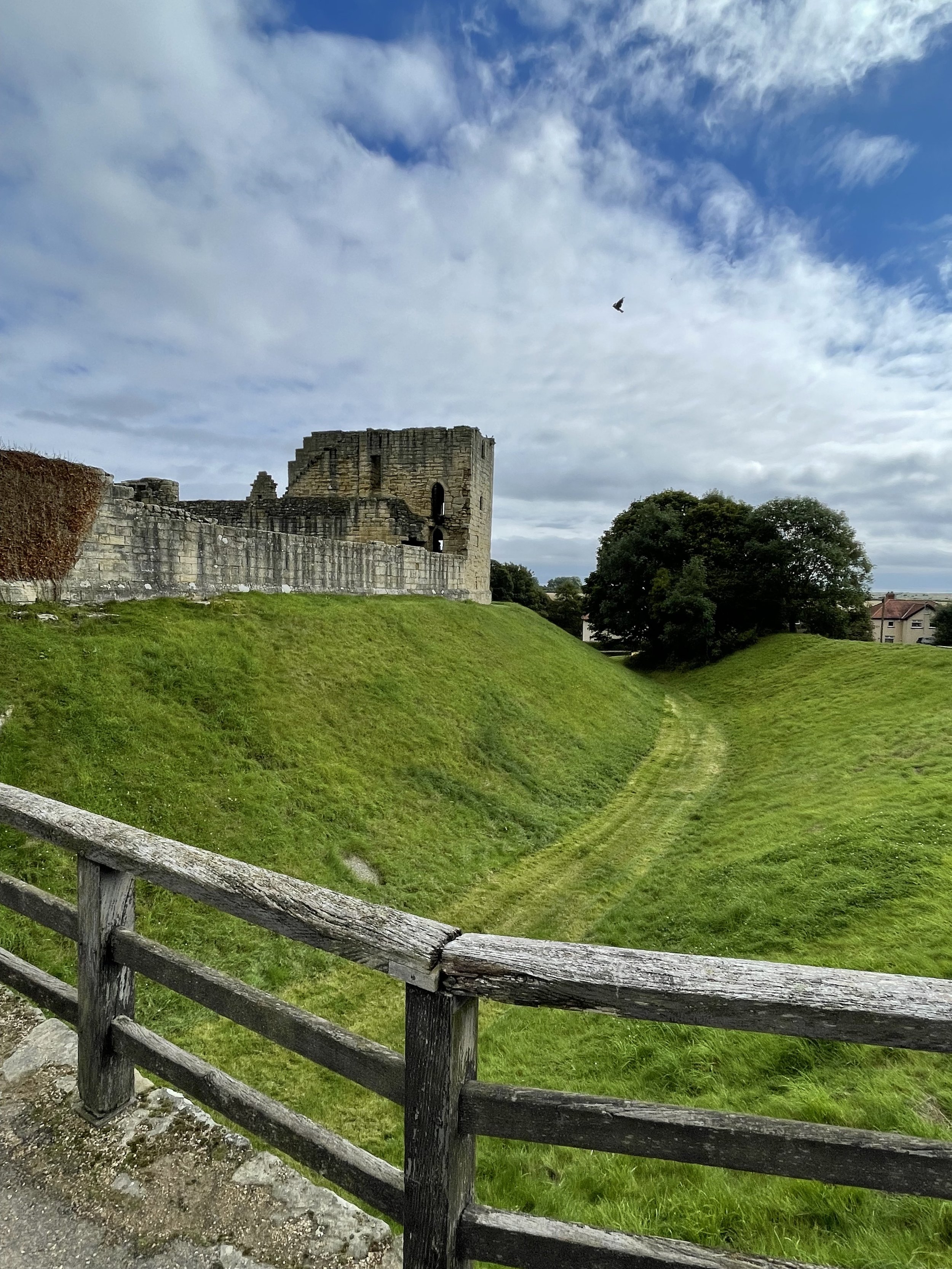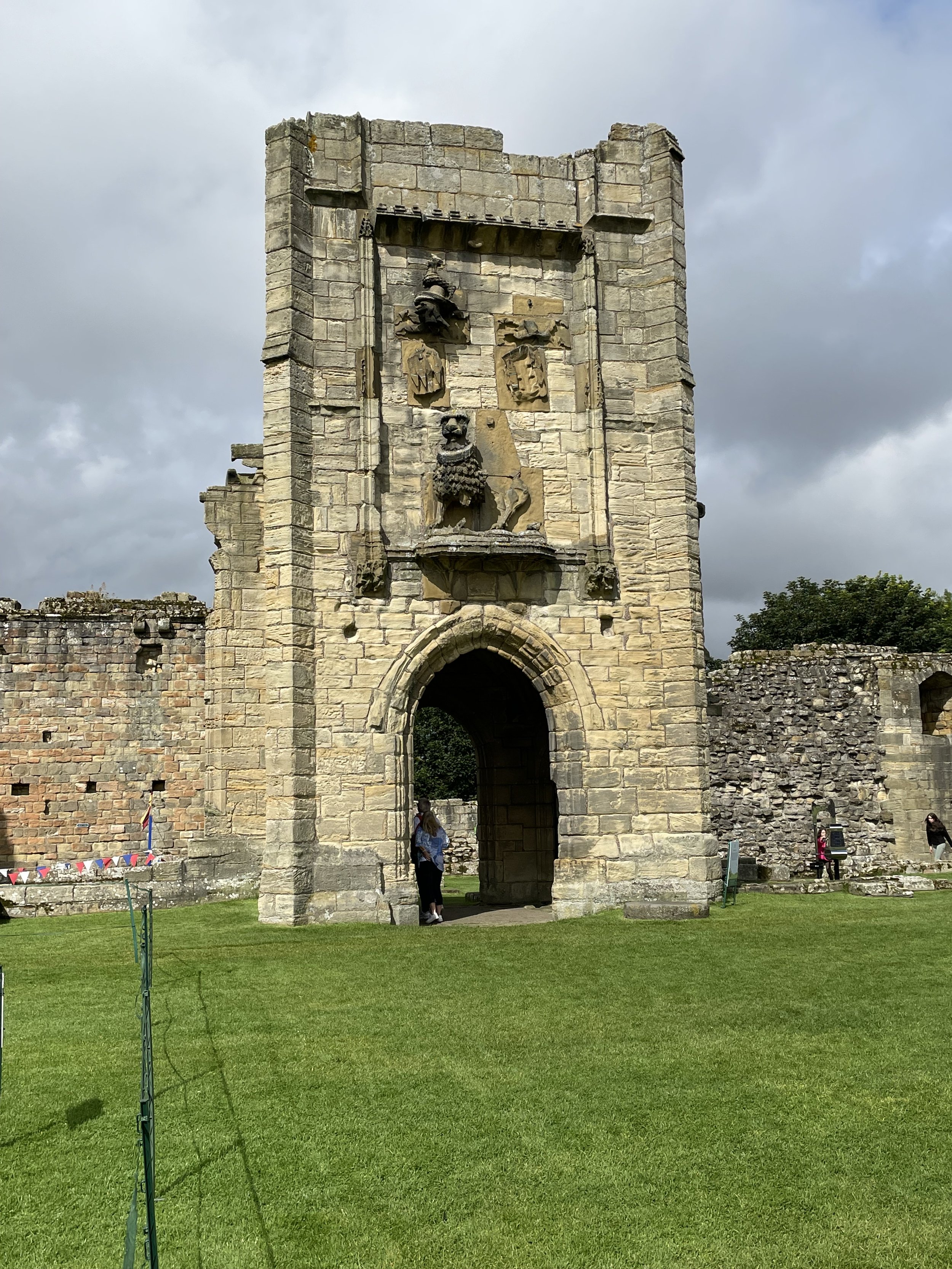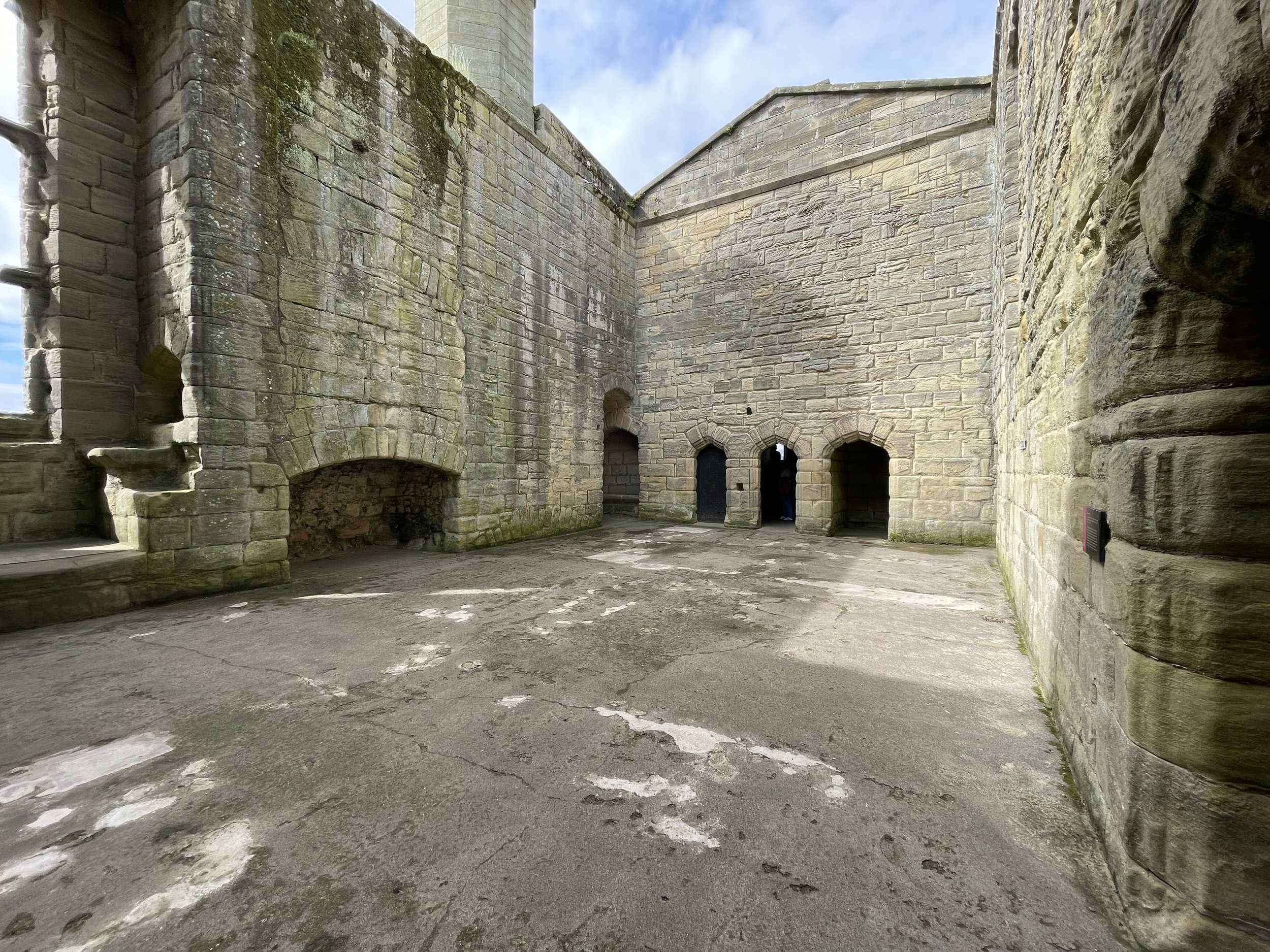Warriors and Castles: Warkworth Castle, Shakespeare's Harry Hotspur and the mighty Percy family in the Wars of the Roses.
/Life in medieval times in the north-east of England was one full of danger with a constant threat of war. Viking raids, as well as raids from Scotland, were a regular problem and from time to time kings of England came to this area to consolidate their power. Warkworth was owned by the powerful Percy family for over 600 years who preferred it to the much larger Alnwick castle. The Percy’s were renowned for taking some poor decisions in dynastic wars and losing their lives as well as their properties and titles. One Percy known as “Harry Hotspur” became a popular knight and has been remembered over the years for featuring in Shakespeare’s Henry IV part one.
Above; Warkworth’s gatehouse. Note the arrow on the right side of the photo which indicates a rather long arrow loop. Also arrowed is a feature which might well be machicolations, this is where unpleasant substances were poured through holes down onto any enemy who approached the door. The worst substance I have heard about was quick lime which is a strong alkaline substance that burnt people’s skin, especially their faces as they looked up. Water would not help the victim, it needed to be an acid that would neutralise the alkaline quick lime. Where could a victim get acid? A fellow soldier’s urine! Quick lime would have had to be made in advance and so I don’t know if it was used very often but it was a possibility.
Above; walking through the gatehouse you will notice some grooves in the wall. These are for portcullises. Below; is a good example of a portcullis at Warwick Castle.
Above and below; the moat, both left and right of the gatehouse. It is pretty deep today and so without all the soil and debris that has fallen into it over the years it must have been even deeper. This would make it difficult to successfully attack.
Above; inside the bailey, you immediately come across this marvellous model. I have numbered a few key features.
Carrickfergus Tower
The Gatehouse
The Montagu Tower
The Stable
The Well House
The Grey Mare’s Tail Tower
The Great Tower
The Collegiate Church. It was never completed and so was demolished.
The Postern Gate
The Lion Tower
The Great Hall
The Little Stair Tower
The Great Chamber
Above; a view from the bailey looking back to the gatehouse. On the right is the Lion Tower and to the left of it is where the Great Hall was situated. The people on the right of the photo were medieval singers.
Above; looking the other way is the Great Tower and in front of it the remains of the dismantled Collegiate Church.
Above; looking from the first floor of the Great Tower onto the Bailey with a better view of where the Church was.
Above; the Lion Tower. Just above the arch is the “Percy Lion” and around its neck, is a collar with the word “Esperaunce” meaning hope. This was the battle cry shouted by the Percys as they went into their numerous fights. Above it, on the left, are the former Percy arms abandoned in 1343 and on the right the three “Lucas” or fishes which were the arms of the Lucy family whose lands were passed on to the Percys in the 1380s.
Above; the Postern gate. This could act as a tradesman’s entrance to bring in supplies. It also acted as a secondary, less obvious gate to allow people to leave and enter the gate inconspicuously.
Below; the next 4 photos are of various rooms in the Great Tower.
A brief History of Warkworth Castle.
The early years
Back in Anglo-Saxon times, there was probably an important wooden residence at Warkworth occupied by the Kings of Northumbria such as King Osbert and later Earls. Osbert was killed by the invading Danes in 867, a constant threat before 1066. There is some debate with regards to when the first stone castle was built but there is a written record dated 1157-64, of Henry II granting Roger Fitz Eustace a castle with an accompanying manor. Henry came to power after a long civil war, sometimes called the “Anarchy” and destroyed loads of illegal castles, ie ones without royal permission. However, in this case, he foresaw problems at the border with Scotland and so was in favour of such a fortification. In 1173, Northumberland was invaded by William the Lion, King of Scotland who sought out Warkworth to destroy it and in 1174 Warkworth was attacked by the Earl of Fife. He went on to capture and massacred all the villagers, even those who fled to the Church of St Lawrence!
In 1213, two years before his death, Warworth was visited by King John who made Roger’s son, Robert Sheriff of Northumberland and one of John’s officials with appropriate power. It was Robert who built the gatehouse, Carrickfergus Tower, the postern gate and the east curtain wall.
In 1290 Edward I, aka Edward Longshanks and “Hammer of the Scots” was recognised as overlord of Scotland but his choice of King of Scotland, John Balliol, was unpopular. He stayed for a night at Warkworth in 1292 and by 1296 he had had enough and decided to invade Scotland. The following year, 1297, the English lost to the Scots at the Battle of Stirling and Warkworth’s owner, Robert and his son, John, were both captured by the Scots.
Above; Edward I
In the late 1290s the Grey Mare’s Tail Tower was built and a garrison was now based there with the role of deterring raids as well as supplying men to make incursions across the border.
In 1327, during the reign of Edward III, Warkworth was actually besieged by the Scots. Although it was unsuccessful, the Scots came back in 1341 and ransacked the Warkworth village once again.
Above; Edward III
The Percys takeover Warkworth.
In 1328, Edward III granted the castle to Henry, 2nd Lord Henry Percy. This recognised Henry was “on the up” because he already owned the larger Alnwick castle. Please note, there were a lot of Henry Percys and so chronology can easily become confused. In 1377, the 4th Henry Percy achieved further status by being made the 1st Earl of Northumberland. It is said that to celebrate or commemorate his rise, he built the Great Tower.
It was the first Earl who was the father of “Harry Hotspur” of Shakespeare’s Henry IV part 1fame. Harry was probably born in Alnwick in 1364, although some sources state it was at Warkworth. Aged 8 Harry accompanied his father as a page, to Brittany to fight in the Hundred Years War. In 1376 he was with his father in yet another Anglo-Scottish war. A year later he was knighted by Edward III and in 1385 he was fighting the Scots along with the new monarch, Richard II. It was here that he got the nickname Hotspur, from the Scots after getting the reputation to always be ready to attack and be quick to act. His reputation as a great knight developed, although in 1388 he and his father were captured by the Scots and then ransomed. Knights and their equipment were worth more alive than dead and chivalry dictated that they should be ransomed for an amount that reflected their status rather than simply be executed.
Above; Richard II
The growing status of the Percys led to more power and influence. In 1399, father and son together conspired with Henry Bolingbroke (later Henry IV) to overthrow King Richard II. With Richard removed, the two of them soon fell out with Henry IV and rebelled again. At the Battle of Shrewsbury in 1403, Hotspur was slain but his father fled back to Warkworth before handing himself over to the king. Henry IV then besieged Warkworth to take it for the crown but failed. The Earl was pardoned in 1404 but rebelled again the following year, 1405. The Earl again ended up being besieged at Warkworth but this time Henry IV had cannons and apparently after 7 shots the Castle’s garrison surrendered.
Above; Henry V
Warkworth castle was now taken over by the crown only to be returned in 1416 to Hotspur’s son, Henry, who was also made the 2nd Earl of Northumberland by King Henry V. He died in 1422 leaving a baby to rule England. By 1455, there was chaos in England resulting in the Wars of the Roses. The 2nd Earl of Northumberland and his son the 3rd Earl, supported the Lancastrian side. In the ensuing Battle of St Albans, the 2nd Earl was killed and in the Battle of Towton, in 1461, the 3rd Earl died. Warkworth castle was therefore taken over by the Yorkists. In 1470, the Yorkist king, Edward IV restored the 4th Earl of Northumberland and he was given various government posts.
Above; Edward IV
He showed loyalty to the next King, Richard III and was at the Battle of Bosworth that saw Richard’s death but the Earl failed to commit any troops to support Richard. The winner, Henry VII briefly imprisoned the Earl but soon restored the Earl to his old status and gave him various duties to carry out on behalf of the king.only to be murdered by the rioting citizens of York who opposed Henry VII’s taxation.
Above; Richard III
Below; Henry VII
From here, the castle began to decline naturally and during the English Civil War more damage occured when Parliamentarian soldiers attempted to make it indefensible by removing doors etc. Some restoration took place, especially in the 19th century but its days of national importance, being besieged and the base for the Percys endeavours, were over.
Essential Information
Getting there.
Sat Nav use postcode : NE65 0UJ
In Warkworth; 7 1⁄2 miles South of Alnwick, on A1068
Parking; Parking for approx 48 spaces. Additional parking is in the village nearby (approx 200 metres) or there is a Long Stay car park near the beach (charges may apply).
Parking charges apply to non-members. Parking free for English Heritage members.
Articles that might interest you.



































A day’s wandering around this area of Coventry will present you with hundreds of years of history to discover. You will be able to visit the ruins of the 14th and 15th century church of St Michael that became a cathedral in 1918 as well as the new one next door.. About 160 metres away or a two minute walk, is Holy Trinity church with its amazing Medieval “Doom Painting” which some people believe is the best one in Britain. One minute away, is the wonderful and free Herbert Art Gallery and Museum.